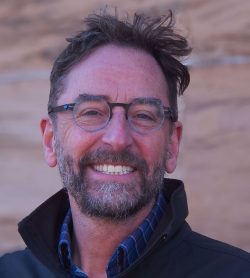
Eric Steig, a University of Washington glaciologist and geochemist, recently was awarded a prestigious Guggenheim Fellowship, an honor given to 188 “culture creators” working across 52 disciplines. Fellows were nominated and chosen based on prior career achievements and exceptional promise, according to the foundation.
Steig, professor and chair of the UW Department of Earth and Space Sciences, is one of two fellows this year to receive support from the John Simon Guggenheim Memorial Foundation’s Climate Change Fund, which was established by a previous Guggenheim fellow to address critical climate change issues. The fellowship will allow Steig, who develops ice core records to understand the history and future of polar ice sheets, to pursue his work free from the constraints of the usual academic life of a professor.
The College of the Environment recently asked Steig about this fellowship.
Tell us about your research and what questions you’ve been exploring lately.
One of the key questions facing scientists who study our climate system is how quickly sea level will rise over the next century and beyond. The greatest source of uncertainty in predictions of future sea level rise is the potential for mass loss from the Antarctic ice sheet. We know that Antarctica is losing ice mostly because warm water is eroding ice shelves — the floating part of glaciers when they enter the sea, but we don’t really know why there is more melting happening now than before.
There are a number of different ideas about why, exactly, this is occuring, and I’ve written a bunch of papers on this, as have my students and colleagues. But at the moment, there is no clear path forward for distinguishing among various competing hypotheses, and each one has rather different implications for the mechanisms of recent Antarctic ice sheet change, and therefore for the response of the ice sheet in the future.
How do you plan to spend your fellowship?
My intent over the course of the fellowship year is to spend time, away from the daily distractions of the university, to work on a review of the existing scientific literature, to try to bring together and potentially reconcile the various competing ideas about why the Antarctic ice sheet is changing. One general problem that I hope to address is that the published literature tends to provide competing ideas in isolation. This is an especially significant problem in the glaciology literature, which tends to ignore publications from oceanographers and atmospheric scientists.
My aim is to try to provide a clearer, comprehensive assessment of the current state of the field, which should help me and other researchers make further progress. While I’m doing this, I also hope to start work on an article on the subject for a more general (non-expert) audience. But the first priority is getting the comprehensive review done.
What makes the Guggenheim Fellowship stand out, and what will it enable you to try?
I think that Guggenheim values creative work — it isn’t tied to a specific outcome the way that a grant from the National Science Foundation would be. Indeed, as the funding documents for the Foundation say, the goal is to allow fellows to “pursue independent work at the highest level under the freest possible conditions.” So I’m free to do what I want — and even to change my mind and do something different. That gives me a lot of latitude to just do the work that I think is most important, instead of worrying about specific deadlines, progress reports, administrative burdens, etc.
How does it feel to receive this award?
It’s extremely gratifying knowing that both a number of people in my research community (who would have written letters of support for me) value my work, and that an independent panel at the Guggenheim Foundation agrees with them. It’s also a huge honor to be in the company of former Guggenheim fellows, such as the great pioneer of glaciology, Johannes Weertman, and various UW scientists such as oceanographer Peter Rhines. And of course, many incredible people — like the jazz great Thelonious Monk, the botanist Barbara McClintock, and the documentary filmmaker Ken Burns — have been Guggenheim fellows. It’s pretty cool to be connected to that history.
Read more about the 2024 class of Guggenheim fellows, which includes artists, photographers, poets, scholars, data scientists, historians and more. The full list of fellows is posted here. Also see a summary from UW ESS.

